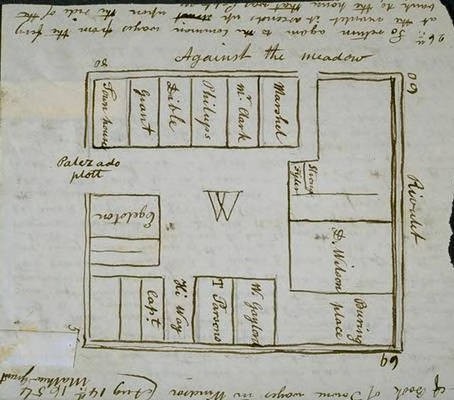Windsor’s location on the Connecticut River shaped the area’s development dating back to its earliest recorded years. Native Americans utilized the river to facilitate trade and develop seasonal agriculture. In 1633, when the English learned of a Dutch trading post in what is today Hartford, Connecticut, they made a concerted effort to establish an English outpost on the Connecticut River to support their growing interest in the fur trade. This brought English settlers to modern-day Windsor.

John Warner Barber, Plan of the ancient Palisado Plot in Windsor – 1634, 1835 – Connecticut Historical Society and Connecticut History Illustrated
English settlement led to the cultivation of agricultural products and feed for livestock. Because of its location on the river, Windsor became a vital port for merchants who shipped feed, timber, wheat, livestock, tobacco, and other products to the West Indies. It also brought sugar, molasses, and salt to the area, as well as British-made ceramics, hardware, glass, and textiles. The mercantile firm of Hooker and Chaffee maintained a store and several packing houses right off Windsor’s Palisado Green. Small-scale shipbuilding also took place locally, in the areas now known as South Windsor and East Windsor.
One of the most important crops to flow through Windsor in the 18th century was flaxseed. (Flax provided fiber for making cloth while its seeds served for planting and, when crushed, as an ingredient in paint and printers ink.) Nearby farmers gathered flaxseed and sent it to small ports throughout Connecticut for shipment to population centers like New York and Philadelphia. By the middle of the 18th century, Connecticut was the center of North American flaxseed production, and the local economic benefits derived from its shipment ranked only second in importance to those of the West Indian trade.
The American Revolution significantly disrupted Windsor’s shipping trade, however, and the 1810 completion of a drawbridge just down river of Windsor helped nearby Hartford rise in status as the region’s economic leader. In 1824, local entrepreneurs made an attempt to prolong the economic viability of Windsor’s shipping trade by building a canal around the rapids in Enfield, thus allowing for better navigation along the Connecticut River. After meeting with initial success, transportation along the canal slowly died out, however, due to the emergence of the Hartford and Springfield Railroad in 1844.









